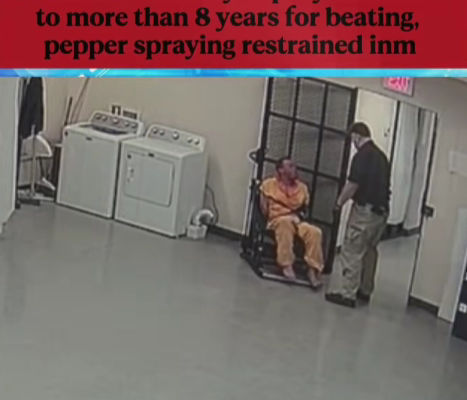A correctional facility in Pike County, which was once seen as a place meant to uphold order and safety, became the center of a disturbing scandal that has now captured national attention. What was supposed to be an environment of accountability instead became the backdrop for a shocking act of violence that raised serious questions about trust, authority, and responsibility. The case, which unfolded over several months, ultimately ended with a former deputy sentenced to more than eight years in federal prison for an unprovoked assault on a restrained inmate.

Shocking Incident Exposed
The case first came to light when video footage surfaced showing a scene that many found deeply unsettling. Inside the correctional facility, an inmate was strapped securely to a chair, unable to move or pose any form of threat. Instead of being protected, the individual was subjected to repeated strikes and direct use of pepper spray by a deputy whose duty was to maintain safety. The victim, unable to defend himself, endured the assault while other officers nearby did not intervene. Federal prosecutors later described the incident as completely unjustified, labeling it not as an act of law enforcement but an act of cruelty. The existence of the footage left little room for denial, forcing both the facility and the public to face uncomfortable truths about what can happen behind closed doors.
The Road to Accountability
For some time, the incident remained hidden, known only to those within the walls of the facility. It took the bravery of whistleblowers—staff members willing to speak up despite the risk—to bring the truth to light. Their testimonies, combined with the video evidence, ensured that the deputy responsible would face charges. During the trial, prosecutors emphasized that this was not a moment of poor judgment but a deliberate act of abuse that violated the inmate’s constitutional rights. At sentencing, the judge strongly condemned the deputy’s behavior, calling it a betrayal of the oath sworn to protect the public. “Wearing a badge is not a license to harm,” the judge declared, underscoring the importance of accountability.
Community Reaction and Growing Anger
News of the case spread quickly through Pike County, sparking outrage among residents, activists, and prisoner rights groups. Many were left stunned that such behavior had continued unchecked until the video surfaced. A spokesperson for Prison Reform Now described the situation as part of a much larger problem. “While this case finally brought justice, countless other inmates endure excessive force without accountability,” the group stated. Families of incarcerated individuals echoed this sentiment, noting that while the sentencing brought relief, it should not take viral video evidence for justice to be served. For them, this conviction was a small step forward, but it also highlighted just how much work remains to be done to protect vulnerable individuals within correctional facilities.
A Troubling Pattern Revealed
Court documents revealed that the deputy in question was not new to allegations of excessive force. Previous complaints had been filed but were either dismissed or quietly set aside without serious review. Civil rights attorney James Reynolds commented that this case was about more than one officer’s misconduct—it was about a system that too often fails to respond until tragedy forces it into the open. He noted that the culture of silence and reluctance to confront wrongdoing within law enforcement institutions creates dangerous conditions where abuse can persist.
Calls for Wider Reform
The sentencing has reignited a nationwide discussion on accountability in law enforcement and the treatment of incarcerated individuals. Experts point out that while the vast majority of officers perform their duties honorably, gaps in oversight create opportunities for abuse. Criminal justice professor Dr. Linda Harper stressed the importance of implementing stronger protections, including mandatory body cameras inside correctional facilities, independent oversight boards with real authority, and strict zero-tolerance policies for excessive use of force. “Without transparency, misconduct thrives,” Dr. Harper said. “Real reform requires systems designed to prevent abuse, not just punish it after the fact.”
National Implications
This case has touched a nerve across the country because it represents a broader issue: the balance of power between law enforcement and the communities they serve. Public trust in the justice system depends heavily on the assurance that authority will be exercised fairly and responsibly. When those entrusted with power instead abuse it, the damage extends beyond the immediate victims—it undermines the credibility of the system as a whole. Advocates argue that this moment should be used as a turning point to push for stronger policies that protect human dignity, even for those serving time behind bars.
A Sobering Reminder
The former deputy’s prison sentence, lasting more than eight years, sends a strong message that misconduct will not be ignored. Yet many advocates stress that accountability cannot stop with a single conviction. True reform requires consistent oversight, strong leadership, and a culture that refuses to tolerate abuse at any level. For the victim in this case, the ordeal will likely leave lasting scars. For the community, the images from the video remain a sobering reminder of what happens when trust is broken. For families with loved ones in the prison system, the case represents both a moment of justice and a renewed call to demand transparency.
Conclusion
The Pike County case stands as a critical example of why vigilance is necessary when it comes to protecting the rights of incarcerated individuals. A badge should symbolize integrity, fairness, and service—not fear or harm. The harrowing footage of an inmate mistreated while fully restrained is a powerful reminder of the importance of accountability in every corner of the justice system. While the sentencing brought closure to one chapter, it also opened the door to a wider conversation about reform. For many, this case is proof that silence enables abuse, but truth, when exposed, can pave the way for change. It is now up to communities, policymakers, and law enforcement leaders to ensure that such violations of trust are never repeated.





